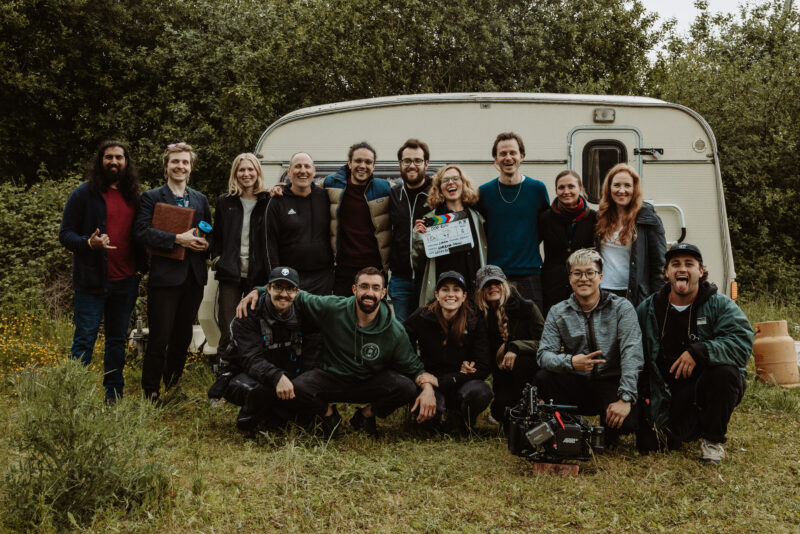Filmed in the West Midlands, Lorna Nickson Brown‘s Kickstarter funded, award winning short Dog Run tells the story of a homeless immigrant caught in the cruel grip of modern slavery. Salvation comes through his growing connection to the natural world and another captive being – the guard dog at the site where he is held. On and off screen, the filmmakers sought to reflect an ethos of harmony, respect and symbiosis between humankind, animal species, and the shared natural environment, while tackling a harrowing story of exploitation and inequality. Embedding this ethos from the outset guided the crew to make conscious decisions about sustainability on this ambitious small-budget production.
Posted on 29th August 2023
How award-winning short film Dog Run sustainably shows us the healing power of nature
We had a conversation with the team behind award-winning short film Dog Run, which tells the story of a homeless immigrant caught in the cruel grip of modern slavery and the healing connection he makes with a guard dog. Read on to see how environmental impact was reduced and how nature was fundamental to the narrative.
Marrying the message with the crew
We find the lead character of Dog Run, Jan (played by Sid Phoenix), immensely challenged as he loses his sense of self and purpose, animals and nature are what helps him overcome his situation. The bond between man and nature is a central theme of the film, which aims to push back on the idea that we, as humans, have nothing to learn from other species.
“Often on production, crew can be disconnected from the central message, but we wanted to have everyone on board with it from the start”
– Lorna Nickson Brown, Writer/Director/Producer
This helped create a sense of equality across the cast, crew and filmmakers, leading to respect for one another and by extension the environment. Dog Run had about 30-35 cast and crew per block of filming, including people on shadowing opportunities, which is quite large for a short film.
The production also sent out green memos reminding everyone that Dog Run was a sustainable production and asked for suggestions based on the crew’s roles and departments.
— Dom Riley, Producer“We were pleasantly surprised by just how on-board everyone on the crew was. For example, the Costume Designer (Maria Thelin) immediately said she was proud to be part of a production that was considering sustainability and took that seriously in her role. The story leant itself to using second-hand clothing and in many cases we needed to make it dirty and worn. So, the challenge was what to do with it afterwards as it couldn't be donated or sold in that condition. Maria found local props house, Revival Props, that could take them to turn into rags, giving them a further use in the workshop
”
Location & Catering
In the film, lead character Jan is forced to work long shifts building driveways of suburban homes, while he himself lives in a caravan in a rural setting. Dog Run was filmed in three blocks (with summer pickups), returning to the location over the changing seasons. Observing this natural beauty, particularly the changes in the oak tree near Jan’s caravan, helped the team to take on board the importance of respecting the environment. All sustainability decisions made, such as having reusable water bottles and vegan catering where both understood and welcomed by the crew.
“It helped that the food was delicious! Seriously though, the cast and crew really took it on board. The crew that came up from London needed overnight accommodation. We asked the hotel to provide a vegan option at breakfast, alongside the usual selection, and several of them stuck to the vegan diet throughout.”
– Dom Riley, Producer
Travel & Transport
About 60% of the cast and crew were local to West Midlands, as a result, carpooling plans were worked out well in advance.
There were a few cases where it wasn’t possible for practical reasons. For example, Dog Run’s sound recordist came from Derby which wasn’t on any other crew member’s route, and the lighting truck had to come up from London. Train strikes also caused some disruption, and two crew members had to fly to the UK, so the team knew at the outset that travel and transport was going to be one of Dog Run’s biggest areas of impact.
To minimise travel, the team to had to look at timings. For their 1st AD (Aaron Dormer), this meant syncing the shooting schedule to line up with Aaron being at his closest base to Birmingham, which was Barcelona, to reduce air miles. For their make-up artist (Kay Childs), the team arranged the schedule so that she could combine the shoot with visiting family in the UK to save her making two trips.
Whilst neither scenario was ideal, the team did manage to minimise impact the best they could under the circumstances.
— Lorna Nickson Brown, Writer/Director/Producer“We got Steve Gill on board as location manager as he's local to the West Midlands. Using local crew is good anyway, but especially location managers - they know the area, they can help to cut the number and duration of journeys by using their knowledge
”
The core location for the shoot was the caravan field where Jan is housed. The team chose a base that offered multiple location options on one site or within five minutes’ walk, such as the oak tree that frequently features in the film. The three caravans were kept in place all year rather than taking them to and from the site for each shooting block. To further reduce impact, production designer Mea Carter sold the caravans to another production at the end of filming.
“The location was good for us. Looking at where the editorial leads are – Jan’s situation, the outdoors, nature, animals – all helped to guide us in our sustainable approach. For example, the respect for animals in the story made the vegan catering choice an easy one, the costume choices made us conscious of the exploitation in that industry, and we opted for mostly natural light. Less than 25 per cent of the film used additional lighting. We opted for battery powered equipment where we could, though weren’t always aware if we were on a renewable tariff or not for recharging. However, regionality can affect choices when it comes to professional kit. For example, we had to bring in the lighting and some camera kit.”
– Dom Riley, Producer
Key takeaways
“My biggest lesson to take away was in getting the crew to take ownership. In conveying the whole ideology of connections between species and nature and how that can improve our wellbeing and purpose, the crew then recognised that in themselves, and it helped to create change in the way we all worked. If you just keep nagging people, it won’t work.”
– Lorna Nickson Brown, Writer/Director/Producer
“Going through the albert process forced me to look in detail at what we could do. The questionnaire prompted me to ask in more detail where I could make a difference. Even if I couldn’t find a way to address a particular aspect of filming, it helped me to identify another area where I could. It also highlighted things that we can do better next time.”
– Dom Riley, Producer
Watch the trailer for Dog Run over on YouTube and follow the film’s journey on Instagram.
Find out more about Dog Run over at IMDB.
Dog Run was the winner of the Breaking Boundaries Grand Prize Award at the Flickers’ Rhode Island International Film Festival.
This case study was undertaken with the support of the BFI, awarding funds from the National Lottery, as part of the Sustainable Screen Fund to support all BFI National Lottery awardees in building environmental understanding and action on positive environmental change. Find out more about our partnership with the BFI here.


